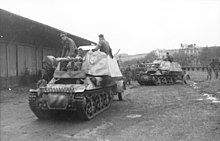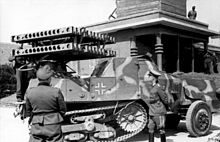Alfred Becker
In December 1939 Becker's division was reassigned and became a part of Army Group B under command of Generalfeldmarshall Fedor von Bock, in preparation for Fall Gelb.
All the guns in Becker's artillery regiment were pulled by horse drawn limbers and caissons, the standard practice for infantry divisions of the Heer.
[3] Becker used other captured Belgian trucks to motorize the field piece transport of his division's reconnaissance battalion, thereby increasing this unit's mobility as well.
[5] Following the German victory in France in July 1940 the 227th Division was assigned occupation, security and coastal defense duties along the Normandy coast near Le Havre.
[12] Becker's personal relationship with Deutsche Edelstahlwerke Gmbh in Krefeld secured the 20 mm thick armor plates used to protect the crew compartment.
[17] Alkett had earlier made a conversion vehicle when they mounted a 4,7 cm Pak (t) anti-tank gun on a French Renault R35 chassis, and from May to October in 1941 had produced 174 of these Panzerjäger Geschützwagen.
In August 1942, one of the Becker-designed vehicles was withdrawn at the request of the German Army High Command, the Oberkommando des Heeres (OKH), and shipped to Berlin.
The Army Ordnance Department had made use of the Alkett plant in Berlin for this kind of work previously due to their manufacturing flexibility and workers skilled in solving problems in tank construction.
Becker chose the French Lorraine Schlepper ammunition carriers as the platform for a self-propelled 150 mm sFH 18 heavy field howitzer.
[N 1] After Becker had completed this project he was ordered by Hitler to return to France, take an inventory of all remaining British and French armored vehicles, and determine if they were suitable for German requirements.
Though lightly armoured and under-gunned by the combat standards of the day, these were fully tracked vehicles, a feature which Becker believed could be usefully exploited.
[5] In addition to the wrecked and captured French and British tanks, Becker also had access to a large number of soft-skinned half-tracked vehicles such as the SOMUA MCG and the smaller Unic P107.
[16] He organized his men into special parties to commence a thorough search of the occupied territory in the west for wrecked vehicles previously thought useful only for scrapping.
Becker's basic idea for the conversion was straightforward in principle: he would build a prototype of the replacement superstructure by framing it out of wood panels and sending these to Alkett.
Battling the cold and engaged in heavy fighting, over time their vehicles were slowly lost, either due to mines or from direct fire from Soviet tanks.
[22] The 227th Infantry Division was involved in heavy fighting near Leningrad defending against the Red Army's main offensive at Sinyavino Heights and the south shore of Lake Ladoga.
Making use of mandatory leave requirements, the commander of the 227th Infantry Division sent ten of Becker's Krefelders back to Germany each week.
In addition he used the SOMUA MCG as a platform for a number of weapons, including the Nebelwerfer, the Vielfachwerfer, and the Reihenwerfer, his own creation of a battery of up to twenty 81 mm mortars.
[27] Over the course of 1943 a number of other high ranking German officers visited Baukommando Becker, including Erich Marcks, Gerd von Rundstedt, and Heinz Guderian.
[43]In the Battle for Normandy the 21st Panzer Division was the only mechanized unit near the area of the invasion, and was the only one with an opportunity to realize Rommel's intentions and meet the invaders at the beach.
Becker's assault gun unit did not take part in the first day's fighting, but by 9 June three of his batteries were providing fire support for the 125th Panzergrenadier Regiment.
[citation needed] In Operation Goodwood, Montgomery committed three armoured divisions in a narrow attack intended to pressure and degrade the German defenders and potentially break out into the open tank country just beyond at Falaise.
The route of the attack would take the British armour through positions held by primarily by the 21st Panzer Division's 125th Panzergrenadier Regiment, under command of Hans von Luck.
Though the land was considered good tank country, the German defenders did not make use of mines as they felt that would interfere with their plans of fighting a mobile defense.
For nearly two hours, the most concentrated aerial bombardment of the war was delivered, with over 2,000 Allied heavy and medium bombers dropping high explosives over the avenue of the planned attack.
The anti-aircraft battery was under Luftwaffe control, but Luck commandeered them, had them moved to the northwest edge of Cagny and instructed them to fire upon the second group of advancing tanks.
Becker's unit communicated using a low frequency radio that had limited range but prevented the detection of the signal of origin by the Allies.
[62] Directing his unit from von Luck's command post, Becker fought his batteries using ambush tactics and a mobile defense.
As the remnants of the 21st Panzer Division retreated across the Seine and back to the frontier, Becker reached Belgium on 22 August and set up his battalion headquarters in Fosses-la-Ville, castle of Taravisée.
[43] Ten years later Walter Spielberger made extensive use of Becker's records and photographic images in his 1989 book Beute-Kraftfahrzeuge und Panzer der Deutschen Wehrmacht (Captured Halftracks and Tanks of the German Military).







